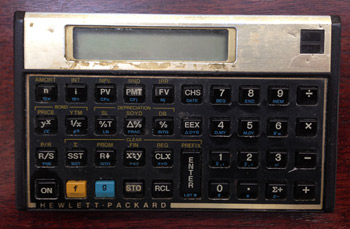I treat my tools with a level of respect that my kids don't quite understand. My notebook computer is always carefully zipped away in its case for protection. I regularly clean my camera gear protecting it from the perils of dust. I faithfully keep my electronic chargeables fully charged so that their lithium-ion batteries can enjoy a long life. I treat my tools well and am proud that they enjoy a long life.
Recently, I had to lay a trusted tool to rest. Our
relationship first started in 1981. I was in college and locking up my bicycle
among a sea of bikes parked in front of the campus library when I noticed a
calculator lying face down on the ground. There was no way to identify its
owner, so I gave it a good home. This Hewlett-Packard (HP) calculator found me
and maybe it knew it would go on to play a significant role in my life. The
HP-12C is a business calculator that somehow knew I was destined for business
before I had declared a major and long before I decided to pursue a graduate
business degree.

The HP-12C uses logic called "reverse polish notation" (RPN) which was so nerdy that I thought it was cool. For many the fact that there was no equal sign on the calculator meant it was flawed. But, I thought learning RPN was a small price to pay to enjoy the power of my new found friend. By the time I got to business school, everyone had an HP-12C. While not an official requirement, it had become an MBA student staple. Worried that I would lose my trusted friend, I affixed some late 80s cool glittery adhesive red tiles to the calculator's face to make it unique and identifiable. The decoration made it even cooler in my eyes.
My skills advanced. I was writing short programs with my HP-12C, but it was also during this same time that the usefulness of a calculator started to come in to question.
I was introduced to a Lotus 123 spreadsheet and the spreadsheet theoretically eliminated the very need for calculators. Sure, my calculator time decreased in favor of spreadsheets, but my HP-12C was always within reach. For the record, I never had an affection for Lotus 123 or later with Excel that I had for my HP-12C.
Maybe it was a coincidence or maybe it was destiny, but my first job out of business school was working for HP. Within a couple of years, my responsibility included marketing the HP-12C. It was about 1990 and I remember visiting the HP-12C's home in Corvallis, Oregon. On that trip I learned that the HP-12C's life was being ended. "We've built the last HP-12C that will ever be built," the vice president declared. He went on to highlight the new line of calculators that were more powerful, easier to use and – most importantly – cheaper to manufacture. I was crushed.
HP found that the market didn't want anything more powerful. They wanted the HP-12C. They quickly backtracked and restarted production of HP-12Cs.
In 1992 I left HP for another opportunity. The company wanted to get me a going away present and asked if I had any requests. I was worried that my HP-12C might not live forever and I asked for a new one. I got my wish. That was in 1992. This is 2015 and my HP-12C only just died.
Calculators are still useful tools. They don't need to boot, batteries rarely have to be replaced or charged, and amazingly, there are still some things that calculators can do faster than modern spreadsheets (even calculators from 1981).
I spend a lot of my day looking at the percentage change between two numbers. You would think that there would be a function or a button in Excel to do just that. After all, Excel is more than 20 years old and has been updated more times than I can count. Here's what Microsoft's website says about the concept of a percentage change function:
In Microsoft Excel, there is no built-in function to calculate the percentage of change from one value to another. However, you can use the following formula to calculate the percentage change:
=(new_value-original_value)/ABS(original_value)
where original_value represents the value that the percentage of change is based on, and new_value represents the value that has changed. Yeah, right. I'll stick to my calculator and its one-button percentage change solution.
I finally took out the shiny new understudy HP-12C that has been waiting to be called up to the big leagues for more than 20 years now. Its buttons are perky and its calculations are precise. It has none of the wear, scratches or character of my old HP-12C.
So as I say goodbye to my best friend, I raise a glass to the tools in our life and all they do for us. I don't know if I'm the only fool that has relationships with his tools. But, even if I am, it's a relationship I'm proud of.
Do you have a tool that means more to you than all others? What's your vote for the most important tool that's ever been invented? Post your answers on our community forum
© Greg Harris, 2017
All Rights Reserved